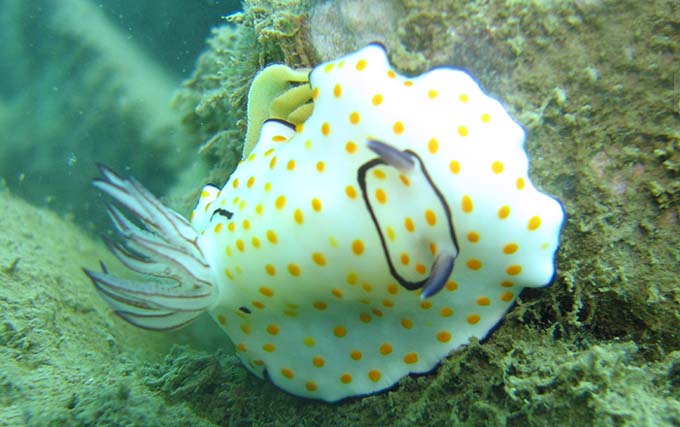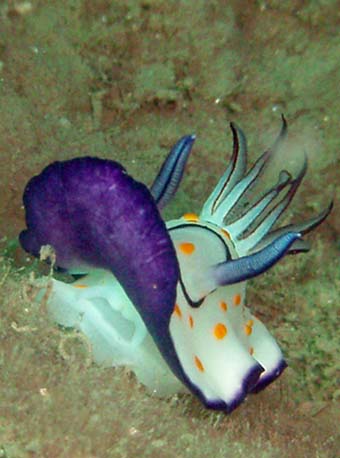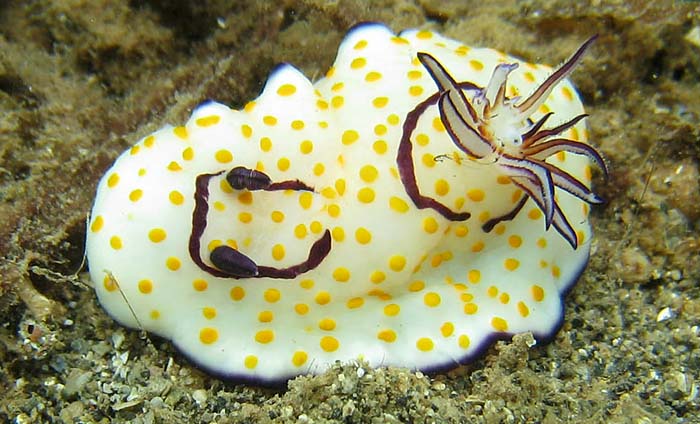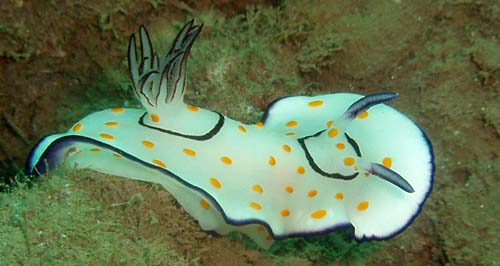This species has been observed on Reunion, Mayotte and Madagascar Islands
The mantle of this Goniobranchus is translucent white with yellow spots, and two violet rings.
One, encircles the gills and another the rhinophores, the anterior end of this ring being just in front of the rhinophore pockets. |

|
|
| Showing species characteristics... | Photo Norbert Verneau "Sec lagon de Petite-Terre", Mayotte, 1 to 3m, 1 June 2008 |
|
See more about : Sightening and mating periods
See more about : Goniobranchus annulatus variability in Southwest Indian ocean
Remarks :
Identification confirmed by Nathalie Yonow
Synonymous : (according Worms)
- Chromodoris annulata, Eliot, 1904
- Glossodoris annulata, (Eliot, 1904)
Bibliographic data :
Most of the Indian Ocean Goniobranchus annulatus has only two purple rings on its back. Specimens from the Persian Gulf have a single median line connecting the two rings to each other.
The front of the mantle forms a veil which continuously waves up and down when crawling.
The gills, quadrangular in cross-section, are arranged in a circle, open posteriorly, around the anus. They wave rhythmically from side to side.
The underside of the mantle is white, with a purple border and in some specimens, but not all, the whole of the underside of the anterior end is purple.
The sides of the body and the foot are white with yellow-orange spots as in the mantle.
G. annulatus is one of 8 species which has a large purple patch on the underside of its anterior mantle and of the 6 species in that group whose food choice we know, all eat Chelonaplysilla. Some feeding observation suggest that they eat the sponge Chelonaplysilla violacea
It coexists with the similarly coloured Risbecia ghardagana and Risbecia pulchella
Risbecia ghardagana |
Goniobranchus annulatus |
||
| Maximun size | 110 mm x 30 mm | 55 mm x 13 mm | 64 mm x 20 mm |
| Colour of dorsum | Opaque creamy white with purple patches in irregular areas, strewn with yellowish orange spots | Milky white with yellow spots (much fewer in number ) without purple patches | Translucent white with yellow spots, and two violet rings |
| Rhinophore club | Long, purple with white axis | Short, reddish violet, with pink red axis | Long, conical, deep purple |
| Mantle margin | Bluish violet | Deep blue | Deep purple |
| Gills | 20-30, often branched, almost vertical, vibratile | 9-11, never branched, horizontal and non-vibratile | 9-12, vertical and vibratile |
| Egg ribbon | Reddish orange, the free edge is wavy | White, the free edge is slightly wavy, single layer of eggs | Creamy white, with yellow pigment in spawn jelly, the free edge is not wavy |
References :
Bill Rudman Seaslug site : Sea Slug Forum : Chromodoris annulata
Nudipixel Chromodoris annulata
Publications :
Gohar, H. A. F., & I. A. Aboul-Ela. 1957a. The development of three chromodorids (with the description of a new species). Publications of the Marine Biological Station, Al-Ghardaqa, Egypt, 9 : 203-228, pls. 1-5.
Johnson R.F. & Gosliner T.M. (2012) Traditional taxonomic groupings mask evolutionary history: A molecular phylogeny and new classification of the chromodorid nudibranchs. PLoS ONE 7(4): e33479
Rudman, W.B. (1984) The Chromodorididae (Opisthobranchia: Mollusca) of the Indo-West Pacific: a review of the genera. Zoological Journal of the Linnean Society, 81 : 115-273.
Rudman, W.B. (1987) The Chromodorididae of the Indo-West Pacific: Chromodoris epicuria, C. aureopurpurea, C. annulata, C. coi and Risbecia tryoni colour groups. Zoological Journal of the Linnean Society, 90 : 305-407.
Other photos of Goniobranchus annulatus :
 |
Emmanuel Eby
"Longoni harbour", Mayotte, 7 July 2007
Spawn : Creamy white, with yellow pigment in spawn jelly, the free edge is not wavy In this specimen, the posterior violet ring around the gills is interrupted anteriorly |
Emmannuel Eby "Longoni harbour", Mayotte, 13 July 2007 The front of the mantle forms a veil which continuously waves up and down when crawling. The underside of the mantle is white, with a purple border and in some specimens the whole of the underside of the anterior end is purple.
|
 |
Matthias Deuss "Herbier du Faré, petite-terre", Mayotte, 2m, 27 December 2008, size : 35 mm
In this speciemn the two violet rings are interrupted. The gills are translucent white the four edges being purple. |
 |
 |
Christophe Cadet Etang salé on the rocky coast, Reunion, less 1 m, 14 October 2009, size : 30 mm In this specimen, the posterior violet ring around the gills is interrupted anteriorly The gills are translucent white the four edges being purple.  |
More photos from Indian Ocean
See more about : Goniobranchus annulatus variability in Southwest Indian ocean
Mayotte, Goniobranchus annulatus, at Petite terre, by Matthias Deuss
Madagascar, Goniobranchus annulatus, at Nosy Bé, by Alain-Benoît Rassat
